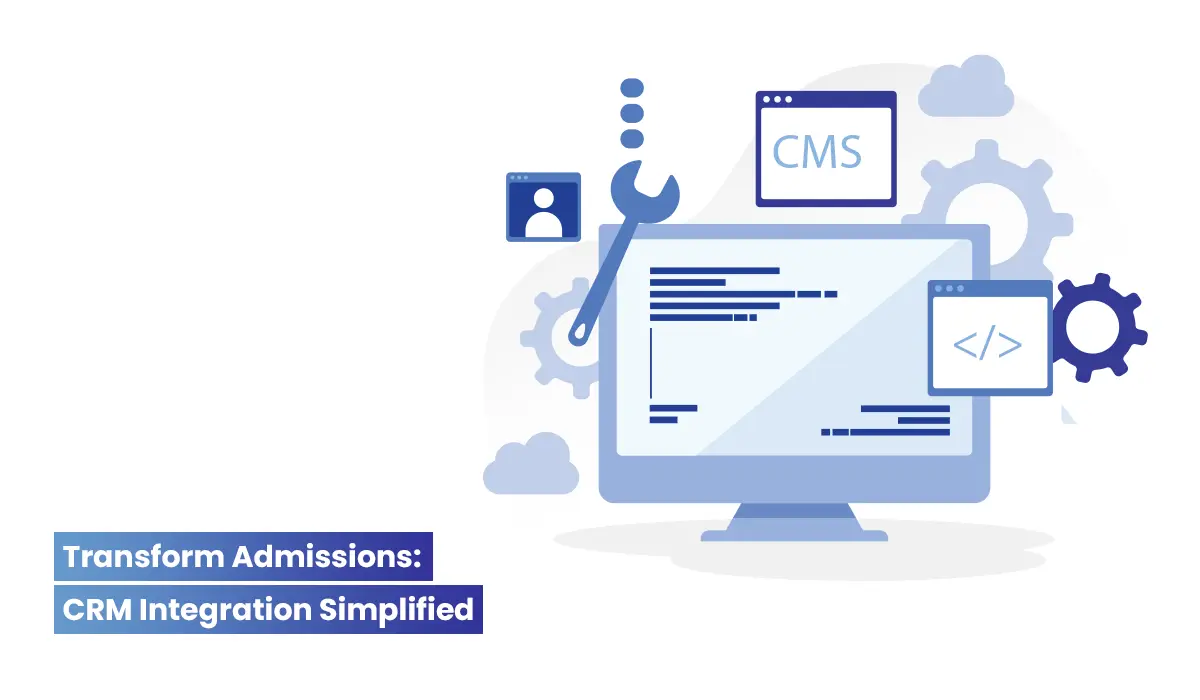Introduction
Dear Admissions Committee: We have been in your shoes; we know how taxing the admissions process would be! 62% of higher ed’s admission teams report experiencing inefficiencies that cause delays and missed chances. You need a more efficient strategy to pull things up.
Let’s clasp integrating CRM for Admissions. This isn’t just a tool; CRM for higher eds is created with your specific issues in mind. CRM allows you to focus on what’s most important: interacting with prospective students in a meaningful way. Let’s discuss more on this in detail in this guide. Let’s work together to reform admissions.
Understanding CRM for Admissions – What is CRM for Admissions?
At its core, CRM / Customer Relationship Management) for admissions is more than just a tool—it’s like your wise assistant, that simplifies and supercharges every bit of your institute’s admissions process. CRM helps manage and earmark prospective students’ interactions, creating a seamless experience from their first inquiry to enrollment.
Key Features that Make a Difference in CRM
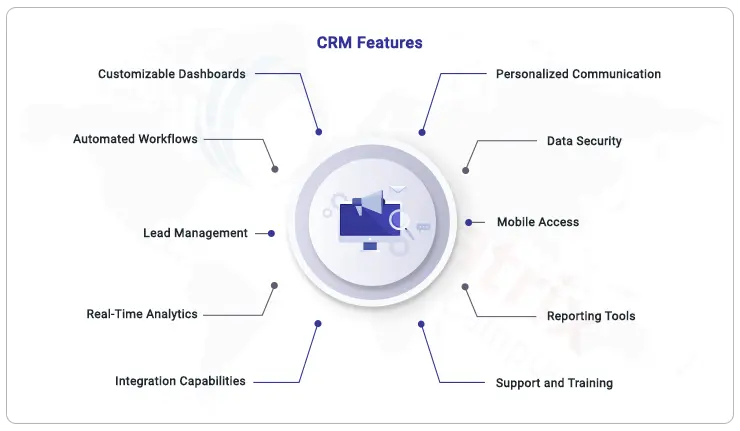
A right higher education CRM doesn’t just organize data; it changes the way you connect and build rapport with applicants. From AI workflows that rule out legacy tasks to built-in analytics that help you track trends and engagement, the CRM keeps everything flowing smoothly. It has tools to facilitate communications with wider outreach and is integrated seamlessly, so you never send back a single applicant unsatisfied.
Why integrating CRM is a Game Changer for Admissions?
It’s a game changer because your team doesn’t have to get bogged down by manual processes anymore and you’re free to focus on building relationships with potential applicants—students. Automation handles the repetitive tasks, giving your team more time to engage meaningfully and create personalized experiences that today’s students expect.
Besides this, CRM also indexes every inch of communication, application status, and documents, ensuring no applicants fall through the cracks. You also get the right data to measure success, and adjust tactics in real time! That’s not all, CRMs come with built-in tools for collaboration, so you get to work with your team together, no matter if they try to track applications, or respond to queries from the office or home, the entire team stays connected and informed, ensuring a smooth, consistent experience for students.
Objectives for CRM Integration
Prior to integrating CRM for your admissions, ensure to lay out the objectives; this will boost its success. Check why you need one. Is it to better communication with applicants, better your mundane tasks, or better route students’ journey? This way of defining goals is essential for an effective CRM implementation.
Set measurable KPIs, such as reducing application processing time by 30% or improving conversion rates by 10%. These goals will serve as a guide to track progress and ensure your CRM delivers tangible results.
Map Out Current Admissions Workflow: Key Steps and Opportunities for CRM Integration
The next important thing to note before CRM for Admissions integration is to map out your existing admissions process. This is a strenuous process of documenting every single step of the admissions roadmap. Chunk them up into multiple core components—application submission, communication touchpoints, document collection, evaluation, and follow-ups.
Now map out the workflow; jot down the challenges and inefficiencies. Are there delays in communication? Are manual tasks, such as data entry or document verification, slowing down the process? Are prospective students facing confusion due to disjointed communications from different departments?
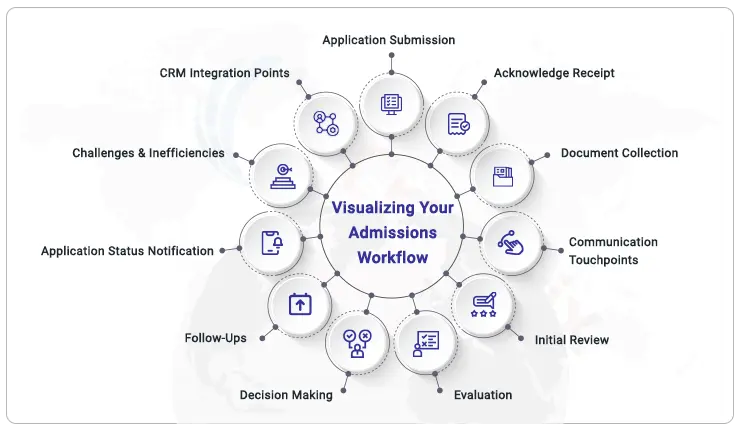
The CRM for Admissions can be used to resolve many of these issues. For example:
- Triggering automatic email communications at various funnel stages can result in faster response rates.
- Employ all possible features of CRM features to chase the applicant’s progress; close them by setting automatic triggers, alerts, or reminders for missing documentation.
- Consider reviewing eligibility based on predefined criteria.
Selecting the Right CRM for Admissions
When selecting a CRM for admissions, prioritize features like customization, scalability, and ease of use to fit your institution’s needs. Look for key capabilities such as lead tracking, personalized communication, and automated responses to streamline the process. Ensure the CRM integrates smoothly with existing systems and offers strong vendor support, training, and easy implementation to ensure a seamless transition. Additionally, consider future growth and how well the CRM can adapt to changing admission trends. A well-chosen CRM for Admissions will help boost efficiency and improve the applicant experience.
Integration with Existing Systems
For a flawless admissions process in your HEI, the CRM for admissions has to be well-knitted with existing technologies like SIS and email platforms, if any. This action assures smooth department-to-department data flow, preventing data silos. Make sure you give top priority to integrations that preserve data flow and accuracy without interfering with regular operations.
A phased planning approach with thorough testing and consistent rollouts is essential for smooth integration. Prioritize data security to protect sensitive information and ensure regulatory compliance. Continuous monitoring and support help address any issues that arise post-integration.
Data Management and Security Considerations
Protecting student data isn’t just a necessity—it’s a responsibility we must take seriously. With 91% of institutions prioritizing GDPR and other data protection standards, your CRM for Admissions should be at the forefront of security. Make sure your system uses the latest encryption and access controls to keep sensitive information safe.
Set clear data governance rules for handling student information and use real-time monitoring to quickly address security issues. Prioritizing these steps will protect sensitive data and build trust with your students and community.
Integrating CRM Admissions – Step-by-Step Guide
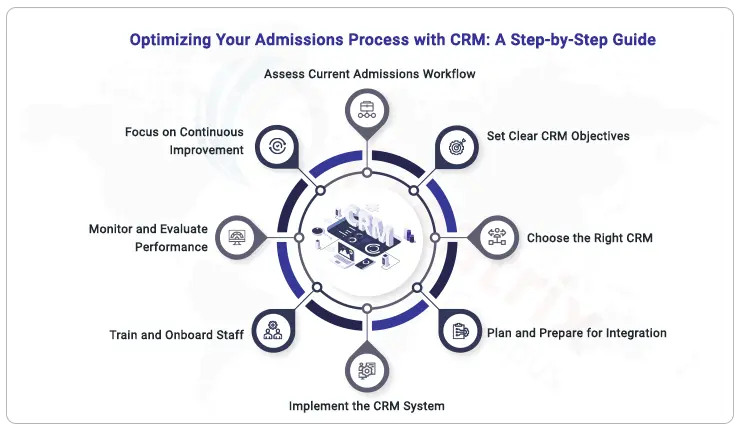
Step 1: Assessing Your Current Admissions Process
Before figuring out that you need the CRM, take a step back and look at your current process. What’s working? What’s not? Jot them all down—ponder if you are meddling with too many manual duties.
Gather honest feedback from your admissions team and even applicants. What are their frustrations? Their insights will guide you in figuring out exactly where the bottlenecks are and how a CRM integration can help smooth things over. This step is all about getting a clear picture of where improvements are needed before making the leap.
Step 2: Setting Clear Goals for CRM Integration
Now that you’ve got a handle on your current process, it’s time to get clear on what you want the CRM to do for you. Is the goal to make tracking applications easier? Improve communication with applicants? Whatever it is, be specific about the results you’re after.
Also, make sure you set measurable goals—things like cutting down response times or boosting the number of completed applications. This way, you’ll know exactly how successful your CRM integration is and can keep your team focused on what really matters.
Step 3: Selecting the Right CRM Integration Solution
Choosing the right CRM is where things get exciting—and a little overwhelming. Look for key features like automation (to handle those repetitive tasks), robust analytics (for tracking performance), and seamless integration with your existing systems.
When evaluating options, think about your institution’s specific needs. Does the CRM integration truly simplify your team’s work? Can it adapt as your institution evolves? Take the time to compare options, dive into reviews, and get hands-on with demos. The right CRM shouldn’t just tick boxes—it should feel like a perfect fit, transforming your admissions process into a seamless experience from the very start.
Step 4: Planning and Preparing for Integration
Start with a clear timeline and assign roles—everyone should know their part. Then, clean and prep your data for a smooth migration. A little planning now means a stress-free integration and faster results.
Step 5: Implementing the CRM System
Let’s get your CRM integration set up just right. Start by customizing it to match your admissions process—think of it as making sure everything is tailored to fit your team’s unique style.
Then, connect it with your current systems, like student databases and email tools. Picture a setup where everything works together seamlessly, making your daily tasks smoother and more intuitive. A well-implemented CRM Software for Higher Education isn’t just a tool; it’s like having a new team member who’s always in sync with what you need.
Step 6: Training and Onboarding Staff
Getting your team up to speed with the new CRM integration is crucial. Think of training as the bridge that connects everyone to a smoother way of working. It’s not just about learning new software—it’s about making sure your team feels confident and excited about using it.
When it comes to training, make it as interactive and practical as possible. Use real examples and scenarios that staff will encounter daily, and offer plenty of opportunities for hands-on practice. Support shouldn’t stop after the initial training—regular check-ins and refresher sessions will keep everyone confident and engaged. By making the learning process enjoyable and relevant, you’ll help your team embrace the CRM integration and make it a true asset in their daily work.
Step 7: Monitoring and Evaluating Performance
After your CRM goes live, think of it as a new member of the team. Keep an eye on how it’s performing by tracking how quickly it handles tasks and how well it’s helping with applications. Keep chatting with your team to see if the CRM Software for Higher Education is truly making their work easier or if there are any hiccups.
Step 8: Continuous Improvement
Numbers from research prove that quarterly reviews and updates on CRM can boost user satisfaction by 15%. Pool in a minimum of 80% of your team members who are the actual CRM users and have a rundown of evaluations of new features. This helps being aligned with your goals and evolving needs.
Benefits of CRM for the Admissions Process
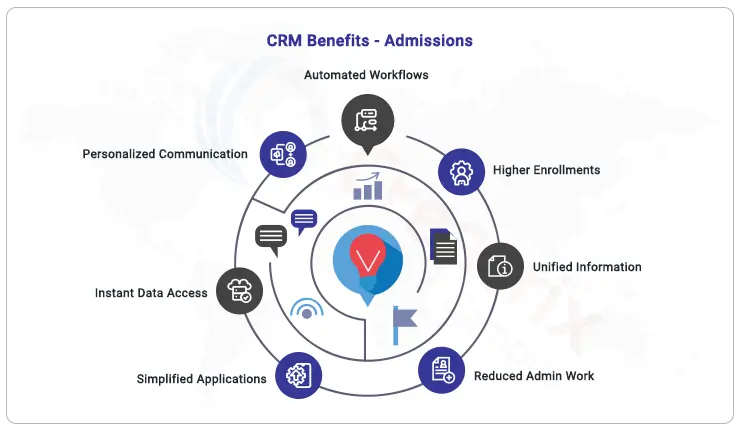
CRM solutions speed up the admissions process by automating processes, improving communication, and delivering real-time data. This leads to shorter processing times, better application experiences, and greater conversion rates. CRMs improve productivity by centralizing data and interactions, allowing organizations to make data-driven choices.
Conclusion
Integrating CRM Software for Higher Education into your admissions process can transform efficiency and effectiveness. Here’s a quick recap of the essential steps:
- Define Your Objectives: Clarify what you aim to achieve with your CRM Software for Higher Education.
- Map Your Workflows: Outline current processes and identify areas for improvement.
- Select the Fitting CRM: Pick the one that matches your needs and goals.
- Instruct Your Team: Make your team become the best users of the system.
- Merge Seamlessly: Loop CRM with your existing or legacy system for a smooth transition.
- Scrutinize, Revise: Review the team’s work and performance, and make tweaks.
- Leverage Automation: Use CRM features to automate repetitive tasks and enhance efficiency.
CRM Software for Higher Education are game-changer in admissions, enhancing personalization, streamlining processes, and driving better outcomes. Ready to see the difference? Explore Creatrix Campus CRM solutions tailored for admissions or request a demo today to revolutionize your process and achieve outstanding results.
#Integrating #CRM #Admissions #Process #Optimization






